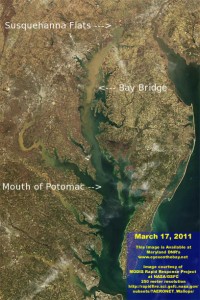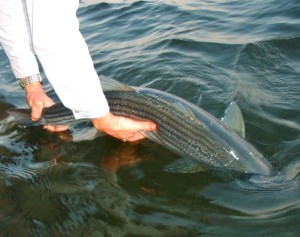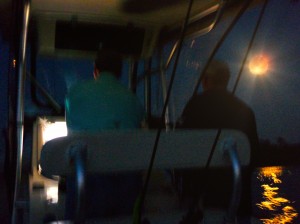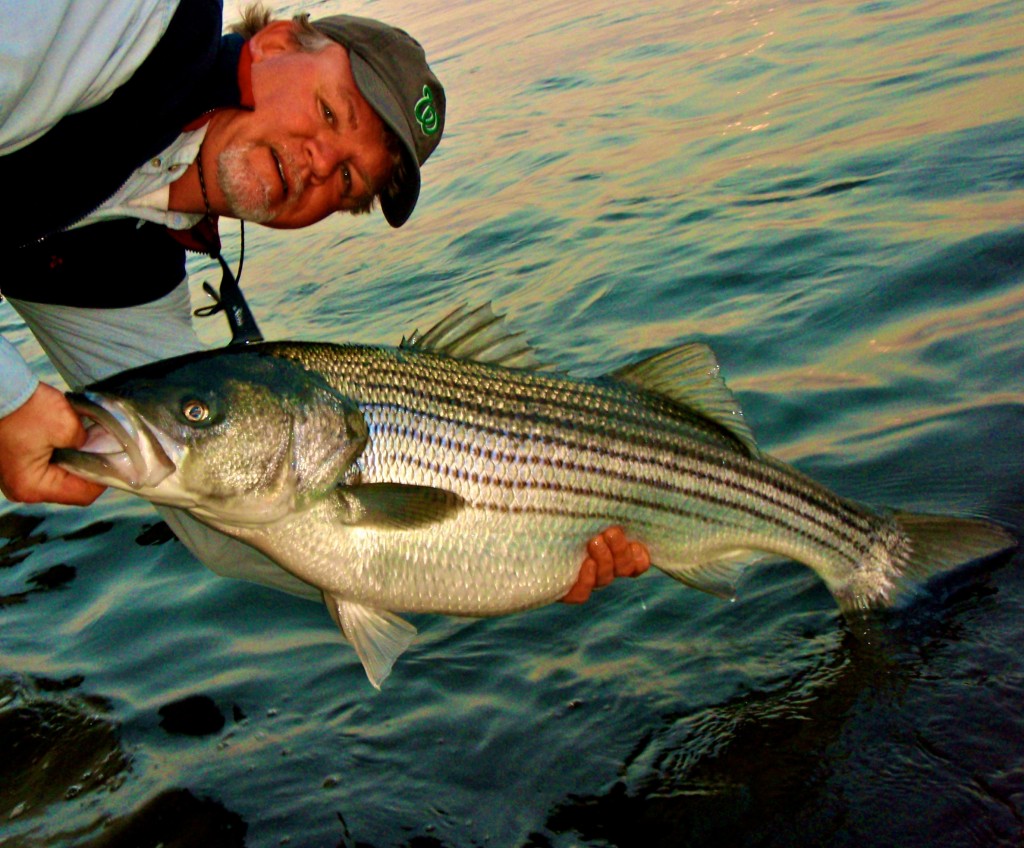 If you’ve looked down at the water flowing beneath the Chesapeake Bay Bridge recently you’ve surely noticed that it’s the color of butterscotch syrup. According to the Maryland Department of Natural Resources, the flow over the Conowingo Dam on March 12 was the highest since Tropical Storm Ivan in 2004. Water clarity is worse than it’s been in recorded history. We’re currently experiencing an annual event called the freshet. Although I never heard the term before I moved to this region, I now know that a freshet occurs in saltwater estuaries when spring rains and snow-melt cause upstream rivers to flood. This results in the additional flow of hundreds of billions of gallons of muddy, sediment-saturated water into the Bay. The map on the left is a NASA satellite photo of the Chesapeake region taken this week. I’ve labeled a few places for reference. It shows a plume of muddy water flowing from the Susquehanna River south though the main stem of the Bay to the mouth of the Potomac River. Note that the water is muddiest in the area between the Susquehanna Flats and the Bay Bridge.
If you’ve looked down at the water flowing beneath the Chesapeake Bay Bridge recently you’ve surely noticed that it’s the color of butterscotch syrup. According to the Maryland Department of Natural Resources, the flow over the Conowingo Dam on March 12 was the highest since Tropical Storm Ivan in 2004. Water clarity is worse than it’s been in recorded history. We’re currently experiencing an annual event called the freshet. Although I never heard the term before I moved to this region, I now know that a freshet occurs in saltwater estuaries when spring rains and snow-melt cause upstream rivers to flood. This results in the additional flow of hundreds of billions of gallons of muddy, sediment-saturated water into the Bay. The map on the left is a NASA satellite photo of the Chesapeake region taken this week. I’ve labeled a few places for reference. It shows a plume of muddy water flowing from the Susquehanna River south though the main stem of the Bay to the mouth of the Potomac River. Note that the water is muddiest in the area between the Susquehanna Flats and the Bay Bridge.
Although the freshet occurs every spring, there is more flow in some years than others. During an average year, about two and a half billion pounds of sediment wash down the Susquehanna into the Bay. In very wet years it can be twice that. It remains to be seen how this spring will turn out, but for now things are above normal. Since there is research proving striped bass spawn more productively in fresher water, the news is both good and bad for fishing.
According to the Chesapeake Bay Journal, high nutrient flows during very wet years can over-fertilize the Bay and create algae blooms. Excess algae clouds the water and prevents Bay grasses from getting the light they need to survive. Eventually, the algae sinks to the bottom and decomposes in a process that depletes the water of oxygen. This reduces the amount of habitat available for fish and other aquatic species. Therein lies the conundrum. Extensive runoff can be good for the spawn but bad for the ecosystem. What’s a concerned fisherman to do?
It all comes down to the quality of the water that washes down the Bay. In a perfect world there would be no perplexity because the spring freshet would be clean and relatively sediment free. In our world the Chesapeake watershed is filled with inefficient waste water treatment plants, polluted air, and excessive runoff from urban areas and farmland. With so many factors working against our fish, I sometimes wonder if there will be any left for our grandchildren to catch. Nevertheless, there are plenty of things individual fishermen can do to help. 
Ten Things Fishermen Can Do:
1. Abide by fishing regulations – Overfishing reduces next year’s catch and disrupts the Bay’s closely interlaced food web.
2. Carefully release unwanted fish – If we conserve our fish, future generations can enjoy the Bay just as we do.
3. Collect all trash for disposal onshore – Keep a trash can on the boat. Most ramps and marinas have dumpsters for trash collection.
4. Keep oil and gas out of water – Oil and gas are toxic to fish. Be careful when filling tanks and changing oil.
5. Contain human waste for onshore disposal – Pollution from human waste reduces water quality and closes areas to fishing.
6. Use anti-fouling paints with care – Paints and solvents can be very toxic to marine life.
7. Prevent cleaners from washing overboard – Even common cleaners cause pollution.
8. Save old antifreeze for onshore disposal – Antifreeze can be very toxic to fish.
9. Avoid boat speeds that cause large wakes – Boat wakes contribute to shoreline erosion and the loss of seagrass beds.
10. Get involved – Each of us living in the Chesapeake Bay watershed are within minutes of one of the streams, creeks, and rivers that eventually drain into the Bay. Today, more than 15 million people live, work, and play in the watershed. If we all commit to altering our behavior to protect our environment, and if we make it clear to the politicians who represent us that the quality of the water in the Bay is a top priority, it will make a difference.
 Since the spring freshet has now washed out the thermoclines around the Bay Bridge, resident fish are unlikely to be holding around the pilings. I’ve been either perch fishing, looking for gannets, or checking in on the warm water discharges. Fishing has been hit and miss but there are occasionally some nice fish being caught and released. There’s a big full “super moon” this weekend and the best fishing has been during the strong incoming tides. There are several reports of gannet storms in the areas south and directly east of the Potomac River, but I’ve yet to find gannets in any numbers farther north. Some of the guys trolling out of Taylor’s Island Campground are reporting very nice fish just to the south of the island.
Since the spring freshet has now washed out the thermoclines around the Bay Bridge, resident fish are unlikely to be holding around the pilings. I’ve been either perch fishing, looking for gannets, or checking in on the warm water discharges. Fishing has been hit and miss but there are occasionally some nice fish being caught and released. There’s a big full “super moon” this weekend and the best fishing has been during the strong incoming tides. There are several reports of gannet storms in the areas south and directly east of the Potomac River, but I’ve yet to find gannets in any numbers farther north. Some of the guys trolling out of Taylor’s Island Campground are reporting very nice fish just to the south of the island.
The biggest fish I’ve heard of this week was caught on a white BKD with a barbless two-ounce jighead by my buddy Phil on Jamie’s boat “Predator.” Since it was the biggest striper he’s ever caught, they brought it onboard briefly to measure it. It checked in at 49 inches and was promptly released. Unfortunately, I don’t have a photo just yet. It might sound unbelievable, but light tackle fish over 45 inches have not been uncommon this winter. We should see schools of big migratory stripers moving into the mid-Bay this coming week. Look for working herring gulls and gannets along the channel edges, especially on the east side. Hopefully the water will clear soon so it will be easier for the fish to see the jigs we drop in front of them.





My wife & I stopped at Conowingo Dam Tuesday March 8 & Sunday March 13. Sunday was the most water I’ve seen coming through there since I lived up there during hurricane Agnes in 1972. I was in the Navy at Bainbridge at the time. It was an awesome sight to see but there had to be a whole lot of sediment coming with the water. Good suggestions on what we can do. Especially like the one about the trash—easy to do & how often I don’t. Amazing how some people just throw stuff away wherever they want. Maybe I’ll see you Tuesday night.
Shawn, great read as usual…I will get phil’s fish pic to you…
Good time last nite..It’s a shame more people didn’t read your “sneak up on’em” report..stealth is important I don’t care where your fishing…See ya this week…..
Shawn: Thanks for the report and pictures. I haven’t been out this year yet because of family matters, but hope to get on the water in the next 2 weeks.
Keep catching em guys.
Tight Lines,
Tom
Shawn,
Your articles are always so interesting. Its amazing how much relevant information they contain over and above the “how-to” info on catching rock. I appreciate the kudos too. See you soon!
Hey Shawn,
Great report and tips for us anglers on how to keep our fish & waters healthy.
The pic of the sun in the one pic is pretty amazing, and the reflection off the water… may need to zoom in to notice it.
Thanks & Take Care!
Tony
Shawn-
Great write up. A friend has decided that he “has” to get some work done on his boat on KI tomorrow so we’ve decided to go for a boat ride on the way.
Hopefully we run into a swarm or two.
Keep up the great writing, videos, pics.
-D
Shawn I noticed that this story got picked up by the newspapers and TV. Good job getting it out there to fishermen first. I also thank you for the information about the freshet. This is the first time I’ve read about it although I see it every year. Jeremy
Good read Shawn.
I heard the rumor of a nice fish being caught..WTG Phill.
Noticed quite a few Gannets on a recent trip from the rod and reel to the rips,seemed to be searching for the most part.
Shawn
Great idea with the dog cam and I hope its waterproof………..woody